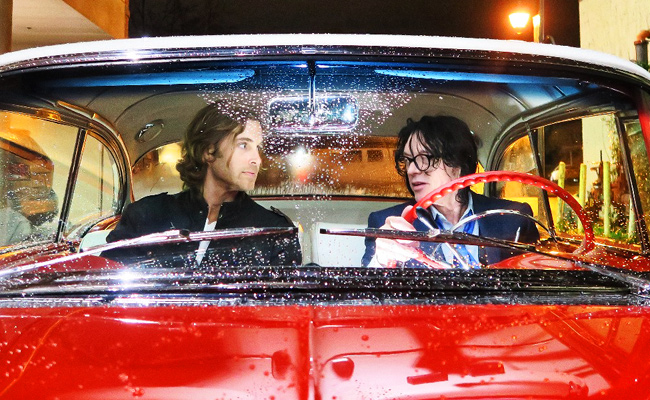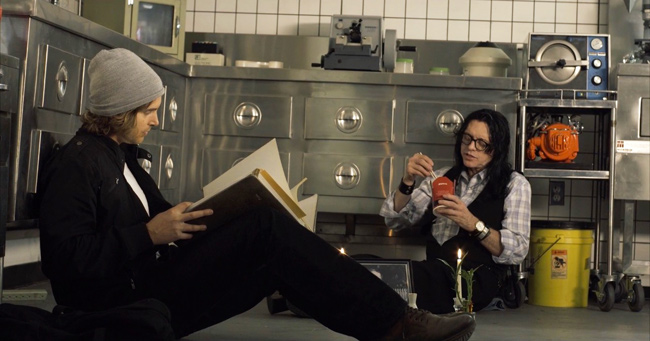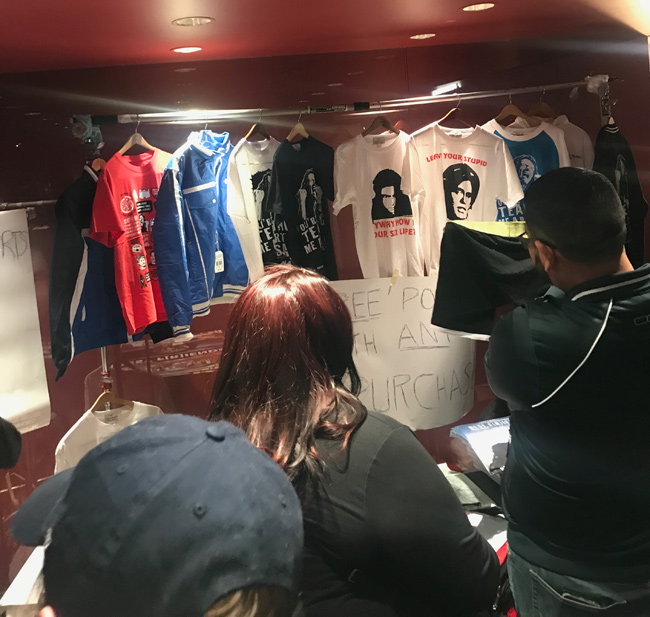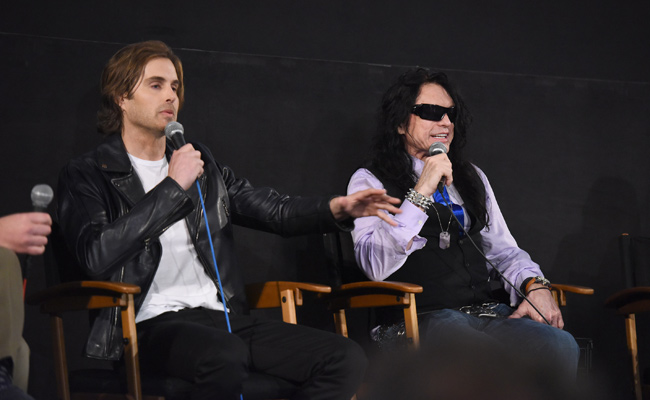
Past the hawkers on Hollywood Boulevard, past a giant merch stand selling “You’re Tearing Me Apart, Lisa!” bomber jackets emblazoned with Tommy Wiseau’s face from The Room, past wig-clad Tommy Wiseau impersonators posing for pictures with other guests, sat Tommy Wiseau himself. He was onstage at Hollywood’s Egyptian Theater (historical site of the first-ever movie premiere, and “the anus of Los Angeles” according to at least one attendee), happily answering questions about his most recent gig: starring in Best F(r)iends, alongside The Room co-star and The Disaster Artist co-author Greg Sestero. The film is scheduled to open in 600 locations beginning this weekend, courtesy of Fathom Events.
Or, not answering questions, as it were.
With Tommy, you never really know what you’re going to get, which seemed to be the guiding principle of the entire event, as well as the film it was designed to celebrate. The Q & A, for instance, came before the movie, an unusual move (“We are Hollywood rebel! Ha ha ha,” said Tommy). Jen Yamato from the LA Times emceed, while Tommy, clad in his trademark Terminator shades and abundance of jingling metal jewelry, including a series of metal rings attached to his waist, flanked by Greg Sestero and Paul Scheer, threw out garbled platitudes and nonsensical one liners, which the crowd ate up.
Scheer has a brief cameo in the film, but perhaps even more relevant for such a surreal event, is a professional improviser. At one point Tommy attempted to bring out a band called The Neighborhood, who debuted a music video starring Wiseau before the film, though he got the band members confused with the theater staff, possibly due to his dark sunglasses.
Conspicuously absent was the actual director of Best F(r)iends, Justin MacGregor, who was present only as a name at the end of the credits. Which lead some in attendance to wonder whether he even existed.
“He was in Vancouver,” Sestero, who also wrote Best F(r)iends, texted me after the event. “He saw The Room when he was 16 and we really clicked on movies we liked and what kind of film we wanted to make — not trying to recreate The Room but attempt to make film with a totally different feel and take Tommy seriously.”

Oh right, Tommy. What was that I said about him not answering questions?
“I enjoyed to do acting,” Tommy said at one point, drawing snickers from the audience over his unique syntax and verb conjugation. Which in turn prompted mild but clearly visible indignation from Tommy.
When asked what happened to Lisa’s mother in The Room, who matter-of-factly tells Lisa “I definitely have breast cancer,” and then mysteriously disappears from the story, Tommy responded “Love is blind.”
And then a beat later, “She survive, for God’s sake!”
Another audience member asked Tommy’s favorite Burt Reynolds movie. “I take my fifth,” Tommy said. “In America, we have choice.”
Asked his favorite genre of movie, and favorite movie of that genre, Tommy starts in with a diatribe. “When you talk about comedy, you talk about drama. When you talk about drama, you talk about comedy, I don’t know if you know that.”
“I don’t know if you know that” is one of Tommy’s, and the crowd’s, favorite Tommyisms, a verbal tic that is at once child-like and pedantic.
Scheer’s answer to the same question is “Biopic; Ghostbusters,” which drew a big laugh. Sestero’s is “Noir, Sunset Boulevard,” which drew applause.
Sestero’s earnest answer is a clue to his strange place in all of this. He may have shot to fame on the strength of a famously inept movie that cinephiles love to laugh at, but he clearly shares a common language with those same cinephiles. He’s both the butt of the joke and in on it, prepared to ride this wave wherever it takes him. 15 years after The Room and only months removed from the awards run for The Disaster Artist, James Franco’s adaptation of the book Sestero co-authored with Tom Bissell, that wave has led him here, to an auditorium full of eager Room fans desperate for Tommy to say something weird, happily buying up The Room merch as if this were a punk show.

Later that night Yamato relates an anecdote about hanging with Sestero at a film festival, where she watched him get starstruck at the sight of director Paul Thomas Anderson, who was at the same party. She said she watched Sestero approach cautiously from afar, only to have Anderson immediately recognize him and get starstruck in turn. They talked for a bit and then went their separate ways, and as Anderson passed Yamato on his way out he excitedly told a friend “I just met Greg from The Room!”
“Are you laughing all the way to the bank?” someone asks Tommy.
“To the bank and from the bank,” Tommy responds, in one of his more coherent answers.
“Yes, you, Mr. Tuxedo Man,” Tommy says later, choosing one of the raised hands.
Mr. Tuxedo Man stumbles a little over the name of the film — fiends or friends? — a title Greg says he landed on after “eating an edible.” Tommy pounces. “No, it’s ‘Friends.’ Do you hear right? No no no, let me correct you, not this way, not that way, it’s this way: ‘Friends.’ It’s not a theme. Right, Greg?”
It’s a poignant plea, Tommy, whose fame was built on audiences reacting to a work differently than it was intended, insisting that this work be received only in exactly the narrowly proscribed way in which it was intended. And also, hilarious. I was left gasping for breath any time Tommy went in on an audience member (or Yamato, for that matter, whom he corrected for saying “500 screens” instead of 600, the number he insists is the correct one). You never quite know what’s going to set him off. Wiseau turns any situation surreal. The entire Q & A, in fact, is predicated on this phenomenon. Simply asking Tommy a series of boring questions can lead to garbled malapropisms, legit zingers, impromptu lectures, or incoherent rants, all compelling (something I know all too well from personal experience).

That’s sort of the idea behind Best F(r)iends, in fact. Tommy Wiseau doing deliberate comedy = bad. I think we all know this by now. Whereas simply adding Tommy Wiseau to an otherwise normal situation quickly turns it surreal — comedic, luridly fascinating, occasionally sad, but above all unpredictable. Employing the third person, Tommy says the goal of Best F(r)iends was “we prove the world: Tommy can act!”
I don’t know if that’s quite true, but if The Room showed us the dark, tragic side of Tommy Wiseau — the outsider desperate for acceptance, who gets betrayed and taken advantage of by everyone, with an undercurrent of latent misogyny — Best F(r)iends gives us the lighter, charming side of Tommy, giving everyone familiar nicknames and turning small talk into weird impromptu songs. It gives us the side of Tommy that helps explain why Greg might’ve wanted to hang out with him in the first place. Or at least, why Greg puts up with him. He’s a wildcard, a blunt foreign bull in a polite China shop, occasionally a pain in the ass, but there’s sweetness in there that’s hard to deny.

In Best F(r)iends, Wiseau plays Harvey, an eccentric undertaker who makes rubber celebrity masks for disfigured dead people. He drives around his LA neighborhood in a bright white hearse tricked out with purple running lights and parks it behind a motorized gate spray-painted with the words “1-800-Autopsy.” If the premise on paper sounds like it’s trying a little too hard to be weird, in practice, the undertaker part fits. There’s a poetic symmetry to Tommy (who wears Clark Kent-style clear glasses as Harvey, lightening his entire countenance and somehow making him seem much more sympathetic than The Room‘s Johnny) playing a lonely eccentric dedicated to the dead. It draws on both his nocturnal hermit weirdness and his old-fashioned romanticism.
Sestero, meanwhile, plays Jon, a homeless drifter with a blood stain on his shirt from an unspecified accident and a head full of bad memories. Not to mention a weird, chinless beard that, incredibly, makes the fine-boned ex-runway model look a little like Tony Clifton. Sestero’s flowing mane and gym-bulked physique seem equally implausible on a homeless man.
Jon and Harvey become unlikely friends, with Jon eventually becoming Harvey’s assistant in his corpse-masking business. In one scene Harvey mentions a dwarf who’s been killed in a terrible accident with a tree, that he’s going to send to paradise looking like Marlon Brando. The weirdness makes for the occasional laugh, but the heart of the film is the Jon/Harvey dynamic, and what it says about the Greg/Tommy dynamic. Jon ends up having to translate Harvey to the outside world and soften his rough edges, especially when they go into business together selling dead people’s gold teeth. There’s a little of the Mickey Rourke/Eric Roberts dynamic from The Pope of Greenwich Village, though Greg definitively cites his influences as “Nightcrawler, Drive, and Double Indemnity” (which manifest in some fairly obvious ways throughout the film).
If The Room was a perfect, unintentionally revealing expression of its creator’s id, one of the most striking impressions Best F(r)iends leaves is of Sestero knowing Wiseau better than Sestero knows himself. Harvey is much more fully realized than Jon, who bounces between tragic loner, leech, and well-meaning nice guy. Still, it’s more about their dynamic. Harvey initially sees Jon on the street holding a novelty panhandling sign, “family killed by ninjas, need $ for karate lessons,” and thus spends the first half of their relationship referring to Jon as “Ninja Guy.” It’s the kind of nickname that sounds eerily familiar coming from a guy you’ve just heard call someone “Mr. Tuxedo Man.”
If Best F(r)iends was meant to show that Tommy Wiseau can really act, I don’t know that it entirely succeeds, but I firmly support anyone casting Wiseau in a straight man acting role. There’s an indescribable magic to watching Tommy Wiseau attempt to be normal. Best F(r)iends strikes me more like if the oddball, semi-employed aspiring character actor types who populate the minor roles in a Tim and Eric sketch or a bit on Nathan For You (or a Brent Weinbach YouTube video, for the true comedy heads out there) attempted to do a semi-improvised feature film, John Cassavetes style. If that sounds intriguing and magical and full of pathos… well, it is. Where will a Tommy Wiseau and Greg Sestero improvisation about a clown corpse go? Who knows, but it’s fun to find out. The fact that they don’t overtly attempt comedy is what allows it to be compelling rather than needy, a quality amplified by the spooky, bittersweet score (by Imagine Dragons drummer Daniel Platzman) which might be the best part of the whole thing.
Best F(r)iends ends on a literal cliffhanger — did I mention that this is only part one? Part two comes out in June. Sestero said they just started shooting and realized that they had too much material for one movie (“this is gonna be like Lord of the Rings!” quipped Scheer). I came away thinking paradoxically that part one could use a haircut (clocking in at over two hours it’s a little long, and a movie as surreal as Best F(r)iends really needs some kind of “moment” every five minutes or so, which it sometimes doesn’t manage) and being excited to see part two.
As we filed out, an obnoxious guy with carnations in his hair spouted Room quotes at anyone who would listen, and just outside the auditorium a smash-that-like-button-fam vlogger type filmed himself in front of the hearse, addressing some unseen or future audience. Next to the merch booth, Tommy dutifully signed autographs and took pictures until the last fan had had a chance to meet him. This is, after all, a guy who supposedly made his fortune selling trinkets to tourists in San Francisco’s Fisherman’s Wharf, he knows how to hustle. As with all things The Room, the question lingered: who’s taking advantage of who?
